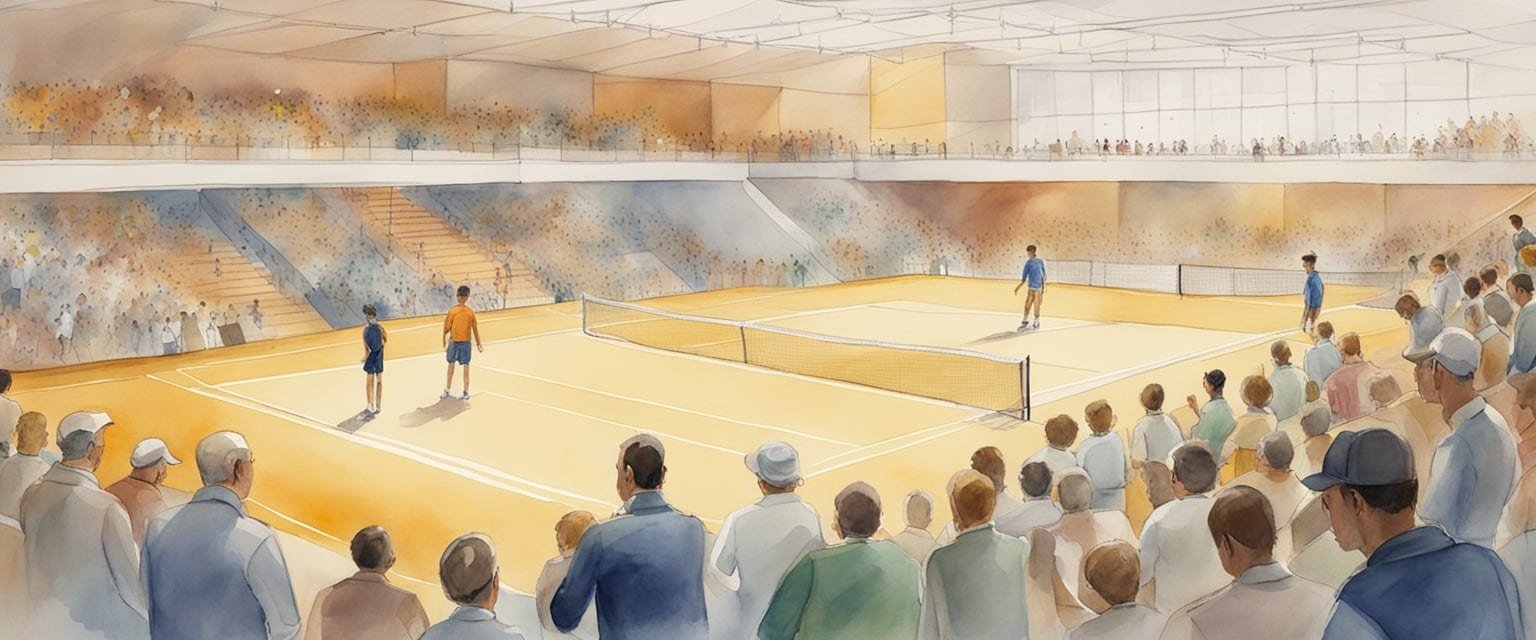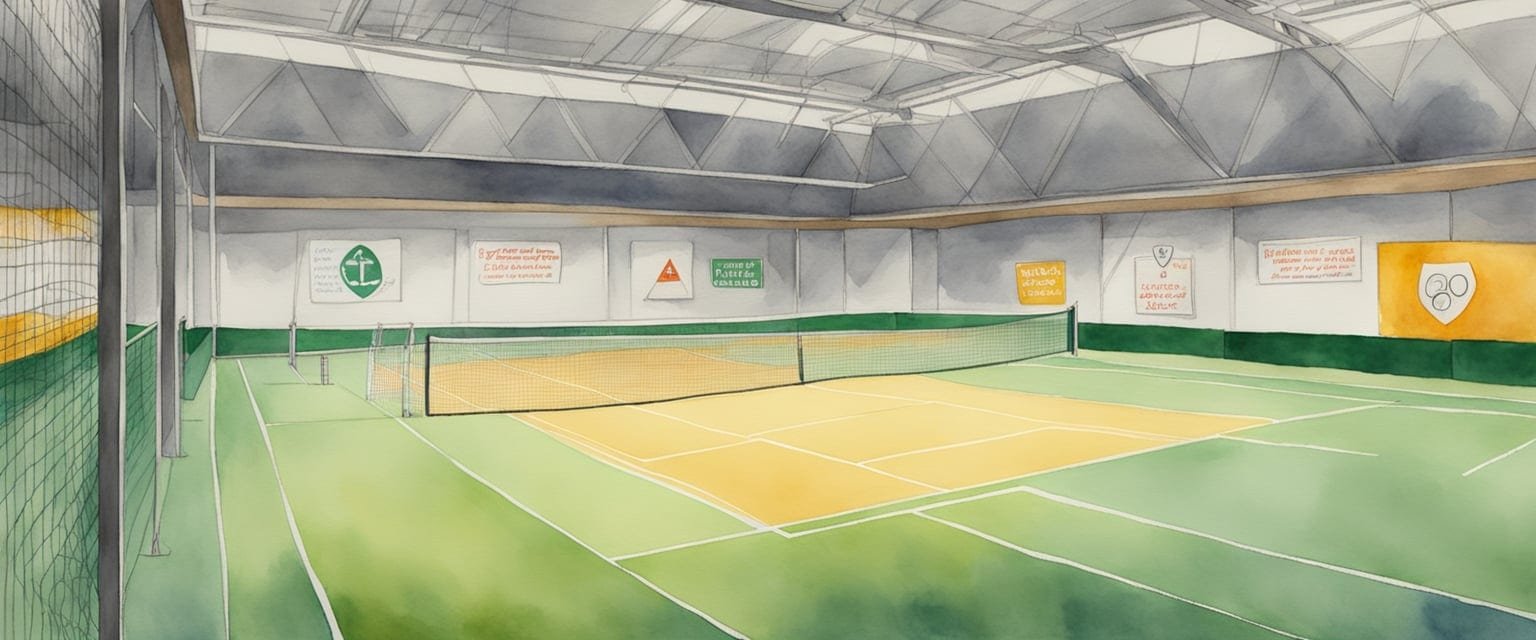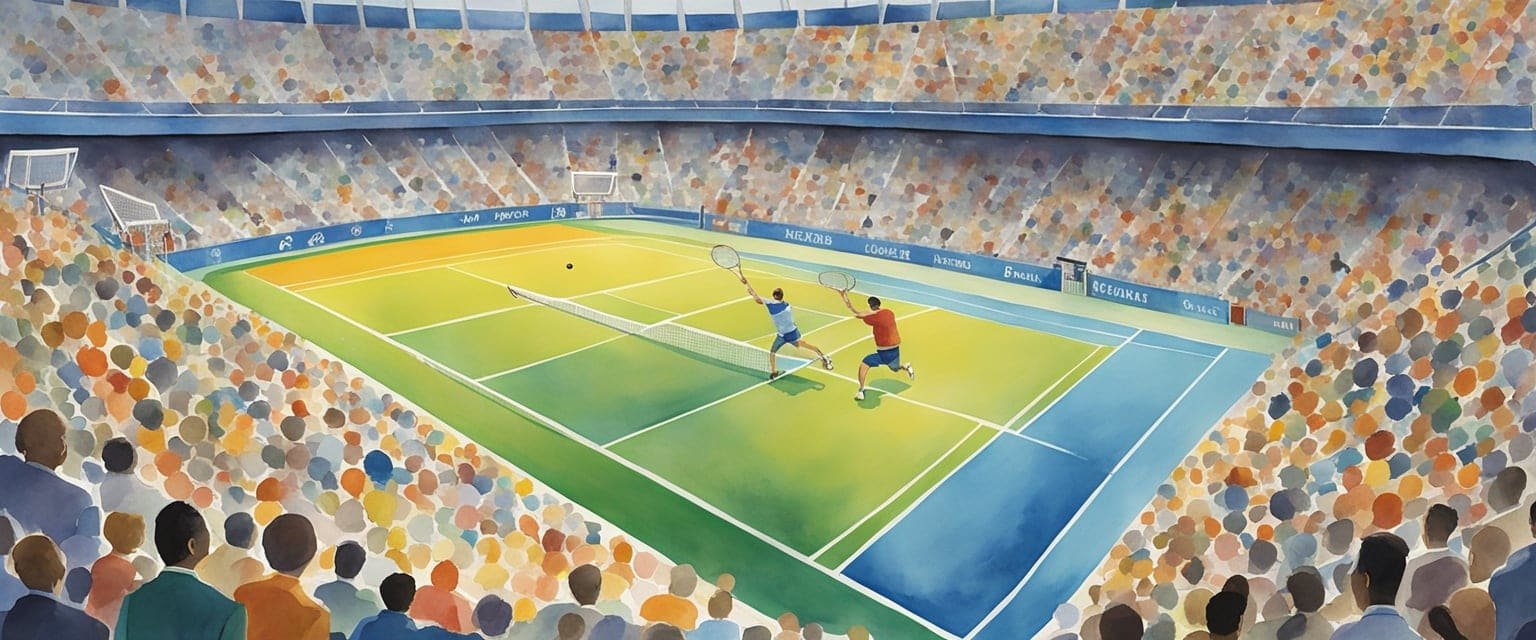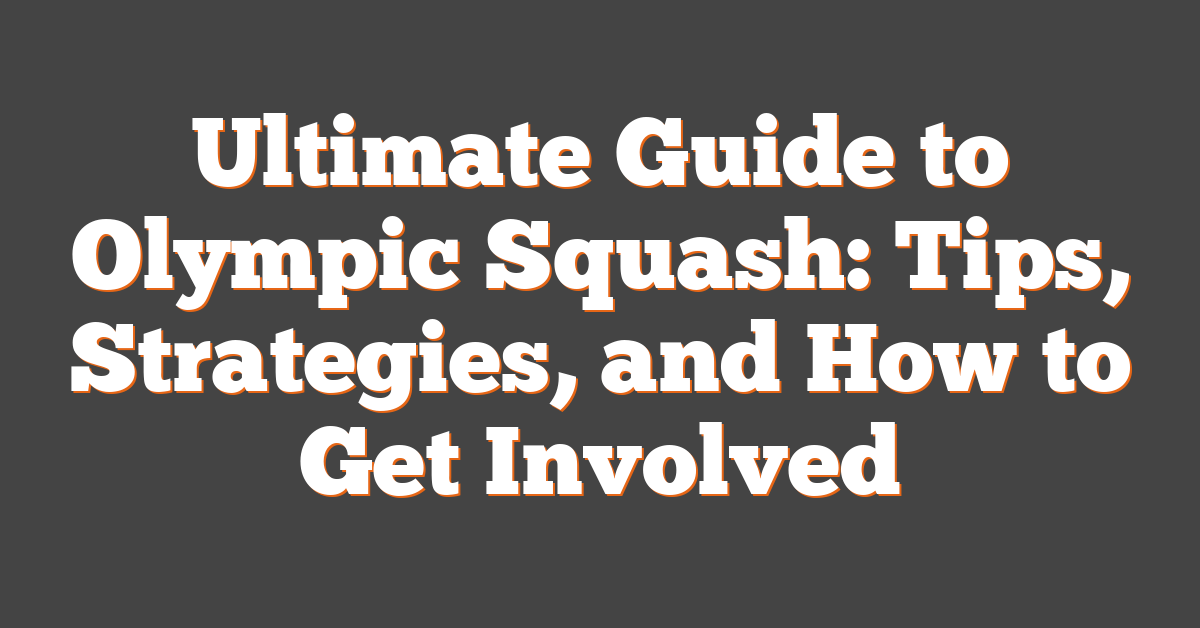Exploring squash as an Olympic sport is truly exciting. This guide will walk you through everything you need to know about Olympic squash, from its rich history to the latest rules and techniques. Whether you are a seasoned player or just curious about the sport, my aim is to help you understand why squash deserves its place on the Olympic stage.

Squash has evolved over the years, gaining popularity across the globe. As it becomes part of the Olympic Games, more people are discovering this fast-paced racket sport. I will also share insights about famous players and memorable matches that highlight the thrill of the game.
Ready to dive in? I’m excited to share this ultimate guide to Olympic squash with you!
Key Takeaways
- Understanding the history and rules of squash is essential for new players.
- Training techniques play a key role in mastering squash skills.
- Watching top players can inspire your own squash journey.
Understanding Squash

Squash is an exciting and fast-paced racket sport that challenges players’ agility and strategy. I find it fascinating how the rules and setup create an engaging environment for both singles and doubles matches.
The Basics of Squash
Squash is played in a rectangular court with four walls. The goal is to hit a rubber ball against the front wall so it rebounds within the boundaries. Players take turns in rallies, trying to score points while keeping the ball in play.
The court features a service line and a tin at the bottom of the front wall. If the ball hits the tin, the rally ends. A match can be played as singles, where two players compete, or doubles, involving four players. In singles, I usually stand close to the front wall and focus on returning the ball effectively.
When serving, I must hit the ball above the service line to start the rally. The ball bounces off the walls, and I try to keep my opponent guessing. Volleys can also happen if I hit the ball before it bounces, adding excitement to the game.
Squash Vs. Other Racket Sports
Squash stands out among racket sports due to its unique court design and rules. Unlike tennis, which is played on a larger court with an open area, squash is confining. The four walls create a dynamic game, as the ball can bounce off any surface.
Also, squash has a specific scoring system. I earn a point whenever my opponent fails to return the ball correctly. In contrast, in many other racket sports, points can be scored only by the server. The game’s pace is intense, requiring quick reflexes and strategic thinking, especially when determining when to serve and how to hit the ball.
In summary, squash’s combination of speed, strategy, and skill makes it a thrilling sport for any racket enthusiast.
History and Evolution
Squash has a rich history that dates back to the 19th century. It began as a game played in London prisons and later evolved into a widely recognized sport. The game continued to gain popularity, leading to its inclusion in international events.
Origins of Squash
The origins of squash trace back to England around the 1830s. It started as a variation of the game of rackets. I find it interesting that Harrow School played a significant role in the game’s development.
Players would hit a soft rubber ball against walls, which created a unique bouncing effect. This sport grew within the walls of schools and clubs. The vulcanization of rubber in the mid-19th century allowed for the creation of better squash balls.
As the game spread, it found fans globally, especially in Egypt, where it thrived. The unique style and rules made it distinct, paving the way for further evolution.
Squash at the International Level
Squash’s journey to becoming a recognized international sport is fascinating. By the 20th century, it was played in many countries. I appreciate how the International Olympic Committee began to recognize its potential.
While squash has yet to be included as a full Olympic sport, it was showcased at events like the Buenos Aires 2018 Youth Olympic Games. This gave it greater visibility and helped build a passionate community worldwide.
Many players and supporters continue to push for squash’s inclusion in future Olympic Games. The quest for recognition reflects the sport’s growing popularity and dedicated following.
Squash Equipment
When gearing up for squash, the right equipment can make a big difference in your performance and enjoyment of the game. It’s important to choose suitable rackets and shoes, as well as the right balls for your level of play.
Choosing the Right Squash Racket
Selecting the right squash racket is crucial for my game. I look for a racket that feels comfortable and suits my playing style. The weight of the racket often affects my swing; lighter rackets offer better maneuverability, while heavier ones provide more power.
Rackets come in various shapes and sizes, which impact their performance. I prefer a racket with a larger head size for more hitting area. Strings also matter; I choose those with proper tension for a balance of control and power. It’s essential to try different rackets to find the perfect fit.
Squash Balls and Shoes
Squash balls are important to how I play. Different balls have varying levels of bounce and speed. As a beginner, I often use balls that bounce higher, making it easier to keep the ball in play. Higher-level players prefer balls with less bounce for a faster game.
Shoes are just as important. I look for non-marking court shoes that provide good grip and support. The right shoes help me move quickly and change direction on the court. With the right gear, I can focus on my game and enjoy squash even more!
The Squash Court

The squash court is an essential part of the game, shaping how players interact with the ball and each other. Understanding its dimensions and unique features is vital for anyone wanting to play or appreciate squash.
Dimensions and Markings
A standard squash court is rectangular and well-defined. For singles, it measures 9.75 meters by 6.4 meters. Doubles courts are larger, measuring 13.72 meters by 7.62 meters.
Key markings on the court help guide the game:
- Service Boxes: Located at the front of the court, these measure 1.63 meters wide and are 1.14 meters long. Players serve from these boxes.
- Short Line: Positioned 4.26 meters from the back wall for singles and 4.57 meters for doubles, it divides the court into two equal parts.
- Out Line and Tin Line: The out line is 4.57 meters high, sloping down, while the tin line is 43 centimeters off the ground. Hitting below the tin results in a loss of point.
Features of a Standard Court
The squash court has four walls: a front wall, back wall, and two side walls. Each serves a specific function during play.
On the front wall, three main lines are visible:
- Service Line: This is also at 1.78 meters and indicates where serves must hit.
- Tin Line: This lower line determines if the ball is in play or not; if the ball hits below this line, it’s considered out.
- Out Line: It slopes down to about 2.13 meters at the back wall, defining the upper limit of playable shots.
With these features, the court promotes quick reflexes and strategic play. Each element plays a crucial role in how the game unfolds, so getting familiar with the court helps in understanding the game better.
Rules and Scoring
Understanding the rules and scoring in squash is essential for enjoying the game. The system can feel a bit complicated at first, but I’ll break it down simply to help you grasp the main points.
How to Keep Score
In squash, the scoring system is known as point-a-rally. This means that points can be scored by either player on every rally. A player wins the game by reaching 11 points first, but they must lead by at least 2 points.
Here’s a basic rundown of how the scoring works:
- Rally: When a player wins the rally, they score 1 point.
- Game: The first player to reach 11 points wins the game.
- Match: Matches are usually played as best-of-three or best-of-five games.
When the score reaches 10-10, the game continues until one player has a 2-point lead. This ensures a clear winner for each game.
Common Fouls and Penalties
Fouls can happen during a squash match, and knowing the common ones helps me play fair. Here are some of the main fouls you might encounter:
Interference: When one player obstructs the other’s movement to hit the ball, it may be called a foul. The affected player can request a let (a replay of the rally) or a stroke (awarding a point).
No Let: If it is determined that interference did not significantly affect the rally, the referee may call a no let, denying the request for a replay.
Penalties can also be given for excessive arguing or unsportsmanlike behavior. It’s key to remember that keeping the game fair makes it more enjoyable for everyone involved.
Techniques and Shots
In squash, mastering various shots and techniques is essential for success on the court. I’ll discuss offensive and defensive shots, as well as effective strategies for shot selection.
Offensive and Defensive Shots
When I play squash, I focus on two main types of shots: offensive and defensive. Offensive shots are designed to score points. The kill shot is one of my favorites; it’s a powerful shot aimed at the front wall that bounces low, making it hard for the opponent to return.
I also use drop shots to catch my opponent off guard. These shots are delicate, gently tapping the ball just over the front wall. The boast can be useful too; it hits the side wall before bouncing toward the front, creating angles that confuse my opponent.
Defensive shots help me regain control. The lob is great for getting the ball high, giving me time to reposition. I prefer using the cross court shot to keep my opponent guessing. It’s a smart way to change the rhythm and create openings.
Shot Selection Strategies
Choosing the right shot is crucial in squash. I often consider my opponent’s position before making a move. If they’re closer to the front wall, a powerful forehand drive or backhand drive can put them on the defensive.
When I notice my opponent is off-balance, I go for a drop shot to take advantage of the moment. I focus on hitting the ball to the corners of the court to make it harder for my opponent to reach, which is where the boast comes into play.
Another strategy I like is mixing up my shots. Using different types of shots keeps my opponent guessing and opens up opportunities. By staying aware of my surroundings, I can make split-second decisions that lead to winning points.
Training and Fitness
Training and fitness are crucial for anyone looking to excel in squash. I focus on exercises that develop specific skills, strength, and overall fitness. This helps improve my game and maintain good health.
Squash-Specific Exercises
When I train, I include exercises that mimic the movements of squash. For example, lateral lunges are great. They help me improve my side-to-side movement, which is essential during matches.
Another key drill is plyometric jumps. These explosive movements enhance my speed and agility on the court. Shadowing my shots—practicing swings without a ball—also helps me perfect my technique.
I also perform core workouts like planks and Russian twists. A strong core stabilizes me for powerful shots and quick changes in position.
Finally, don’t forget about court sprints. These replicate the quick bursts needed during a game and improve my cardiovascular fitness.
Strength and Conditioning
In my strength and conditioning routine, I prioritize functional exercises. They enhance my performance and reduce injury risk.
Resistance training is key for building strength. I often use free weights and resistive bands. Exercises like squats and deadlifts focus on major muscle groups, boosting my overall fitness.
I also incorporate high-intensity interval training (HIIT). It’s effective for improving endurance while keeping workouts engaging. I alternate between short bursts of intense effort and rest.
Don’t underestimate the importance of flexibility. I spend time on stretching and mobility workouts to keep my body agile and prevent injuries.
Combining these elements into my training ensures I’m not just fit but also ready for the various challenges on the squash court.
Famous Players and Matches
In the world of squash, several players have made a significant impact through their exceptional skills and memorable matches. These athletes have not only excelled in their careers but have also shaped the future of the sport.
Influential Squash Professionals
One of the standout players is Nicol David from Malaysia. She dominated women’s squash for over a decade. Nicol held the world number one ranking for a record 108 months. Her achievements included winning the World Open multiple times.
Another remarkable player is Nour El Sherbini from Egypt. She became the youngest player to win the World Championship at just 20 years old. Nour has been a consistent force, winning numerous titles and pushing the boundaries of the sport.
Ali Farag, also from Egypt, has been a leading figure in men’s squash. His quick rise to the top ranks showcases his talent and determination. Alongside him is Nouran Gohar, another rising star in women’s squash. Their skills and accomplishments contribute significantly to the sport’s growth and appeal.
Memorable Squash Competitions
The squash scene hosts numerous thrilling competitions each year. One of the most notable events is the World Championships, where top players like Nicol David and Nour El Sherbini showcase their skills. The intense rivalries create unforgettable matches filled with excitement.
The British Open is another prestigious event, often referred to as the “Wimbledon of Squash.” It has a rich history and attracts the best talent globally. Matches here often involve nail-biting moments and high stakes.
National and regional competitions also play a crucial role in the squash calendar. They help to discover new talents and create thrilling rivalries. Watching these competitions is a fantastic way to appreciate the depth and skill present in the sport.
Playing Squash
Squash is an exciting sport that combines fitness and strategy. Whether you’re looking to join a community or just starting out, there are key steps I can share to make the journey smoother.
Joining a Squash Club
Joining a squash club is one of the best ways to get involved in the sport. It offers a chance to meet fellow enthusiasts and improve your skills. Most clubs have various membership options, so I can choose what suits me best.
Many clubs provide access to courts and equipment, which helps me avoid upfront costs. Additionally, they often organize events and competitions, giving me an opportunity to play matches and gain experience.
To find a squash club, I can check local gyms or community centers. Many also offer trial memberships, which allow me to test the waters before committing.
Starting as a Beginner
As a beginner, I’ve learned that starting with the right grip and stance is essential. I hold the racket with a firm but relaxed grip. My feet should be shoulder-width apart, and my knees bent slightly for better balance.
I also focus on getting comfortable with the basic rules of the game. Squash is played in a rectangular court, and my goal is to hit the ball so my opponent cannot return it.
Practicing regularly is crucial. I find that the more I play, the better I understand the game. Many clubs offer lessons for beginners, which is a great way to pick up skills and strategies from experienced players.
In preparing for my first competition, I remind myself that practice and confidence are key. Before long, I’ll feel ready to enjoy the game and celebrate progress along the way!
Watching Squash
Watching squash is an exciting experience that brings together energy, skill, and strategy. Whether you are at a live event or viewing from home, understanding the opportunities to spectate and the ranking system can enhance your enjoyment of the sport.
Spectating Opportunities
I love going to see squash events, especially big tournaments like the Olympics, World Championships, and regional competitions. The atmosphere is electric, and the players showcase their incredible skills.
At the Olympic Games in 2028, squash will feature prominently, attracting fans from around the world. These events are often held in stunning venues that add to the excitement.
For those who can’t attend in person, watching squash online is a great option. Many platforms stream live matches with commentary. You can also catch replays to see the best plays.
Understanding Player Rankings
Player rankings are crucial in the squash world. They reflect a player’s performance in competitions over time. Rankings can influence matchups, so it’s interesting to follow.
The Professional Squash Association (PSA) maintains current rankings for players. Rankings are updated regularly based on performances at events. The top-ranked players are often the ones to watch in major tournaments.
In addition to singles rankings, doubles squash is gaining attention as a dynamic format. Watching how players collaborate and strategize adds another layer of excitement to matches. Understanding these rankings can help me appreciate the competition and the talent on display.
Squash Safety and Etiquette

Playing squash is exciting, but it’s important to stay safe and follow proper etiquette. This helps prevent injuries and ensures everyone has a good time on the court.
Preventing Injuries
In squash, the fast movements and close quarters can lead to injuries. To stay safe, I always make sure to wear the right gear. This includes non-marking shoes for grip and movement. Wearing protective eyewear is also essential, especially during competitive play. Safety glass is often used in professional courts, allowing spectators to see the action while keeping players safe.
Before each match, I warm up by stretching my muscles and focusing on my feet. Keeping the heart rate moderate during play is key to preventing fatigue. If I feel tired, I take a break. It’s also wise to stay aware of others on the court to avoid collisions.
Fair Play Guidelines
Fair play is an important part of squash. I always respect my opponents and the rules of squash. Keeping a good attitude, whether I win or lose, is crucial. This encourages a positive atmosphere for everyone involved.
During a match, I make sure to let my opponent know when I’m about to hit the ball. Communication helps prevent accidents. If I feel my opponent is in my way, I call “let” to pause the play and discuss the situation.
I also strive to follow all court rules. This includes understanding shot placement and movement. By playing fairly and respecting others, I contribute to a sport that’s enjoyable for everyone.
Squash Around the World
Squash is a global sport with rich cultural roots and exciting competitions. It’s fascinating to see how different regions embrace this racket game and compete internationally.
Squash in Different Cultures
I find it interesting how squash has developed in various cultures. In Egypt, for example, squash is more than just a sport; it’s a way of life. Egyptian players dominate the world rankings and frequently win international titles.
Malaysia has also made its mark. The country hosts prestigious tournaments, like the Kuala Lumpur Open, attracting top talent. Here, squash is part of the physical education curriculum, helping to grow the sport from a young age.
In England, squash’s birthplace, the sport holds deep historical significance. Local clubs are common, and many prestigious events, like the British Open, originated here. The sport is embedded in community activity.
Global Competitions
Internationally, squash has gained popularity through numerous competitions. Major events like the World Squash Championships showcase the best players worldwide. I’m excited to see how these competitors represent their countries on such a grand stage.
The International Olympic Committee has recognized the sport, adding squash to the Olympic program for the 2028 Games in Los Angeles. This will help increase squash’s visibility and attract new fans globally.
Countries like Egypt, Malaysia, and England consistently perform well in competitions. They each bring their unique playing style, making matches thrilling to watch. Each tournament also emphasizes sportsmanship and camaraderie, uniting players and fans around the world.
The Future of Squash
As I look ahead, the future of squash seems bright, especially with its potential Olympic inclusion and exciting innovations within the sport. These developments could greatly impact how squash is played and viewed around the world.
Potential Olympic Inclusion
Squash is on the brink of becoming an official Olympic sport at the Los Angeles 2028 Games. This development is significant for players and fans alike. It reflects the growing popularity of squash globally and the desire for more diverse sports in the Olympics.
With the International Olympic Committee’s approval, squash could attract more talented athletes. Competing for an Olympic gold medal would elevate the game’s status. The excitement of Olympic competition may inspire younger players to take up the sport and increase viewership.
Innovations in the Sport
Innovations are transforming squash and making it more engaging. Enhanced technology, like video reviews, is ensuring fair play and improving the overall viewing experience. These advancements can help players and referees make the right calls during matches.
Additionally, new training methods and equipment, such as advanced rackets and balls, are enhancing performance. Initiatives to promote squash in schools and community centers are vital for grassroots growth. By tapping into these innovations, I believe squash can thrive and reach new audiences.
Frequently Asked Questions

I often get questions about squash, especially when it comes to understanding the rules, scoring, and strategies. Here are some of the most common questions I encounter.
What are the basic rules of squash for beginners?
The game is played between two players on a rectangular court. Each player takes turns hitting a rubber ball against the front wall. The aim is to make the ball bounce in such a way that the opponent cannot return it. Players must hit the ball before it bounces twice on the floor.
Can you explain the scoring system in squash?
Squash uses a point-a-rally scoring system. Every time a player wins a rally, they earn a point. A match is usually played to 11 or 9 points, and players must win by at least 2 points. If the score reaches 10-10, players continue until one leads by 2 points.
What are the official squash serve rules?
To serve, the player must stand in the service box. The ball must hit the front wall above the service line and land in the opposite box. If the serve hits the tin or lands outside the designated area, it is a fault. Players get two attempts to serve correctly.
How does squash differ from racquetball?
While both games are played indoors and involve hitting a ball against a wall, there are key differences. Squash balls have less bounce, making rallies more strategic. The court layout also differs; for instance, racquetball allows for a larger play area, including a rear wall that players can use.
What strategies can help you win against a more skilled squash opponent?
To compete against a better player, focus on your positioning and shot selection. Staying near the T (the center of the court) gives you better access to return shots. Use a combination of pace and placement to keep them guessing and create openings.
What is the history of squash in the Olympics?
Squash has been proposed for the Olympics multiple times but has not yet made it as an official sport. It was first demonstrated as a medal event during the 1998 Commonwealth Games and has a growing global presence, with many fans hoping for its Olympic debut in the future.

